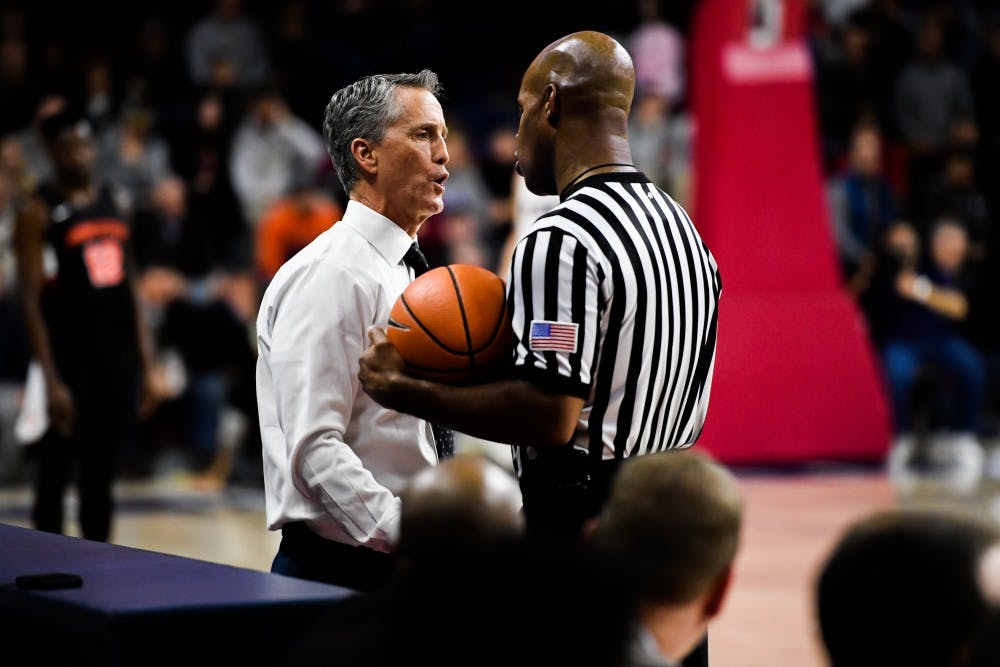
No doubt about it — that was the wrong decision.
In a statement that confirmed rumors were swirling around the event since its inception two years ago, the Ivy League men’s and women’s basketball tournaments will no longer be held at the Palestra.
It was already shameful that the conference moved its showcase — the best teams with the highest stakes in its marquee sport — away from its best and most historic venue. But the choice of Yale’s Lee Amphitheater as the Palestra’s replacement, even if only for a year, makes the decision a travesty.
Let’s review the facts.
Despite how controversial the decision to have tournaments was in the first place, the first two editions were a rousing success, thanks in large part to the Palestra. While the cathedral was never filled to the corners as some may have wished, attendance was strong — about double the capacity of the Lee Amphitheater — and the atmosphere was electric.
The Palestra has history no other gym does; not in the Ivy League, and not anywhere else on Earth. When ESPN opened its broadcasts of the tournament games, broadcasters invariably spoke at length about the history and tradition of the Palestra. That’s good for Penn, but it affects the rest of the League as well.
People want to be at the Palestra, whether that’s the Sixers, sponsors, national media, alumni, or recruits. A guaranteed title game at the Palestra is something recruits across the conference can look forward to. Nobody looks forward to the Lee Amphitheater.
The league has suggested that it wants to hold the men’s and women’s tournaments in the same location. The Palestra’s four locker rooms help them do that.
The only reason not to have the Palestra host permanently is the home-court advantage it gives the Quakers. Though the tournament has been held during Penn’s spring break for the past two years, I won’t deny that the crowd has been pro-Penn.
In 2018, Harvard men’s basketball lost a tightly-contested final in hostile territory. The Crimson had every right to point to the crowd and note their frustrations with their season ending in what was effectively an away game. Instead, coach Tommy Amaker said this to Deadspin:
“Having it here at the Palestra has always been something that I personally have been in favor of. I know that can be controversial in some ways, with some teams, but I do think this is the location and the facility that we’re proud of having in our conference, and this is a great town.”
But with other coaches in the Ancient Eight complaining about their relative disadvantage if the Palestra stayed, the league had to look elsewhere.
Here were some of the options the league had at its disposal:
Keep it at the Palestra despite Penn’s home court advantage.
Move it to a neutral site, potentially somewhere in a central location filled with alumni like New York City. Of the options here, St. Johns’ Carnesecca Arena and its 5,602 seats would have been the primary candidate. Other schools with gyms of appropriate size and in the conference’s geographic area include Boston College, Villanova, Temple, Rutgers, and Albany.
Have the top-seeded team host. This would mean splitting up the men’s and women’s tournaments and thus creating a logistical nightmare for the League and for new media partner ESPN, but would make the home-court advantage a rightly-earned feature as opposed to a controversial one.
Rotate venues among the eight Ivy gyms (which may end up being the Ivy League's plan long-term). Only the Palestra and Princeton’s Jadwin Gymnasium hold enough fans for this plan to make sense. Despite having only half the necessary capacity, new host Yale has an average-sized gym by Ivy League standards. Attendance would be under 5,000 in six of the eight years of the rotation, and below 3,000 for five, based on gym size alone.
What the conference ended up doing was the worst option of the bunch: pick a random non-Palestra Ivy gym as a temporary placeholder. This option solves nothing: there is still an unfair home-court advantage for the host, and the new location is worse from media, sponsorship, and recruiting perspectives.
I’m sure New Haven is a fine city, but it does not possess the alumni base, basketball tradition, or media appeal of Philadelphia. And the 2,800 seat Lee Amphitheater is a worse gym than the Palestra by any metric.
ESPN money in hand, the league surely could have afforded whatever fee St. Johns would have commanded to use its facilities for two days. And if that option had failed and the only solution was to award one of the Ancient Eight with home-court advantage anyways, why not have it at the proven venue, one with the draw and amenities that make the league look so good on national television?
Was the goal to pick a host with a high chance of not making the tournaments? When Yale's men have finished in the top four of the Ivy League in 18 consecutive seasons? If so, why not Columbia, who has even less of a chance, a similarly sized arena, and a far better location?
Simply put, it’s a baffling decision.
One can only hope that the League finds an adequate permanent solution for 2020.
The Daily Pennsylvanian is an independent, student-run newspaper. Please consider making a donation to support the coverage that shapes the University. Your generosity ensures a future of strong journalism at Penn.
Donate







